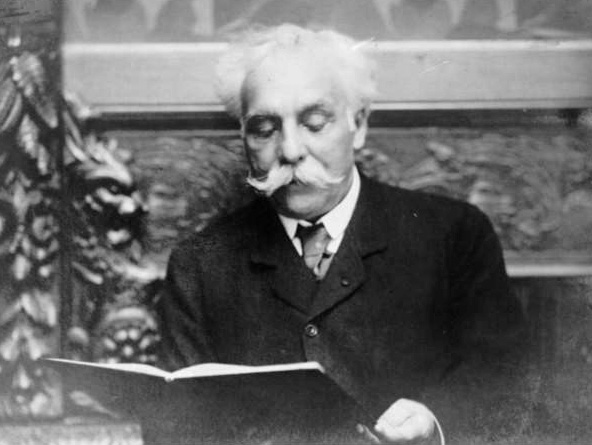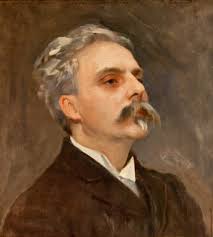Gabriel Fauré (1845-1924) was a pivotal figure in French music, bridging the Romantic and Modern eras with his innovative compositions. Renowned for his melodic inventiveness, harmonic subtlety, and refined expressiveness, Fauré’s works have left an indelible mark on the music world. Here, we explore ten of his best compositions that highlight his genius and lasting influence.
1. Requiem in D minor, Op. 48
Perhaps Fauré’s most famous work, the Requiem is a serene and contemplative piece that departs from the dramatic settings typical of the genre. Its ethereal “Pie Jesu” and the comforting “In Paradisum” stand out as some of the most beautiful and moving sections. This composition reflects Fauré’s view of death as “a happy deliverance, an aspiration towards happiness above, rather than as a painful experience.”
2. Pavane, Op. 50
The Pavane is a light, elegant piece originally composed for piano and later orchestrated with optional chorus. Its graceful melody and sophisticated harmonies have made it a favorite in the concert hall and popular culture. The piece evokes the charm and elegance of the French courtly dance after which it is named.
3. Après un rêve, Op. 7, No. 1
One of Fauré’s most beloved songs, “Après un rêve” (After a Dream), captures the ephemeral beauty of a dreamt love. Set to a poem by Romain Bussine, this art song showcases Fauré’s gift for lyrical melody and subtle harmonic shading. Its emotional depth and simplicity make it a favorite for vocalists and audiences alike.
4. Clair de Lune, Op. 46, No. 2
Not to be confused with Debussy’s famous piano piece of the same name, Fauré’s “Clair de Lune” is part of his song cycle Deux mélodies, Op. 46. This hauntingly beautiful song, set to a poem by Paul Verlaine, perfectly captures the elusive and dreamlike quality of moonlight, showcasing Fauré’s sensitive handling of text and music.
5. Cantique de Jean Racine, Op. 11
Composed when Fauré was just 19 years old, this work for mixed chorus and organ (or orchestra) demonstrates his early mastery of choral writing. Set to a paraphrase of a text by Jean Racine, the “Cantique” is serene and uplifting, with flowing melodies and rich harmonies that foreshadow Fauré’s later sacred works.
6. Nocturnes for Piano
Fauré’s thirteen Nocturnes span much of his career, offering a glimpse into his evolving style. These pieces are characterized by their lyrical beauty, innovative harmonies, and emotional depth. Notable among them is the Nocturne No. 6 in D-flat major, Op. 63, which is particularly admired for its sophisticated and intricate writing.
7. Dolly Suite, Op. 56
Originally composed for piano four hands, the Dolly Suite is a delightful collection of six pieces dedicated to the daughter of Fauré’s mistress, Emma Bardac. Each piece, such as “Berceuse” and “Kitty-Valse,” is charming and playful, reflecting the innocence and joy of childhood. The suite was later orchestrated by Henri Rabaud, adding another dimension to its appeal.
8. Violin Sonata No. 1 in A Major, Op. 13
This early chamber work is a testament to Fauré’s genius for melody and structure. The sonata’s four movements blend passion, elegance, and lyrical beauty, making it a staple of the violin repertoire. Its balanced interplay between violin and piano showcases Fauré’s skill in writing for both instruments.
9. Piano Quartet No. 1 in C minor, Op. 15
The Piano Quartet No. 1 is one of Fauré’s most popular chamber works, known for its expressive depth and structural ingenuity. The quartet’s blend of lyrical themes, rich textures, and dynamic contrasts make it a cornerstone of the piano quartet repertoire. The energetic finale, in particular, is a tour de force of rhythmic vitality and harmonic inventiveness.
10. Masques et bergamasques, Op. 112
This orchestral suite, later turned into a stage work, is a nostalgic look back at the French Baroque and Rococo periods. The suite’s four movements, including the lively “Ouverture” and the charming “Gavotte,” are infused with elegance and grace. The work highlights Fauré’s ability to blend past and present, creating music that is both timeless and fresh.
Fauré’s compositions continue to enchant and inspire musicians and listeners alike. His unique voice, characterized by lyrical melodies, subtle harmonies, and emotional depth, ensures his place as one of the great masters of French music.


Comments are closed